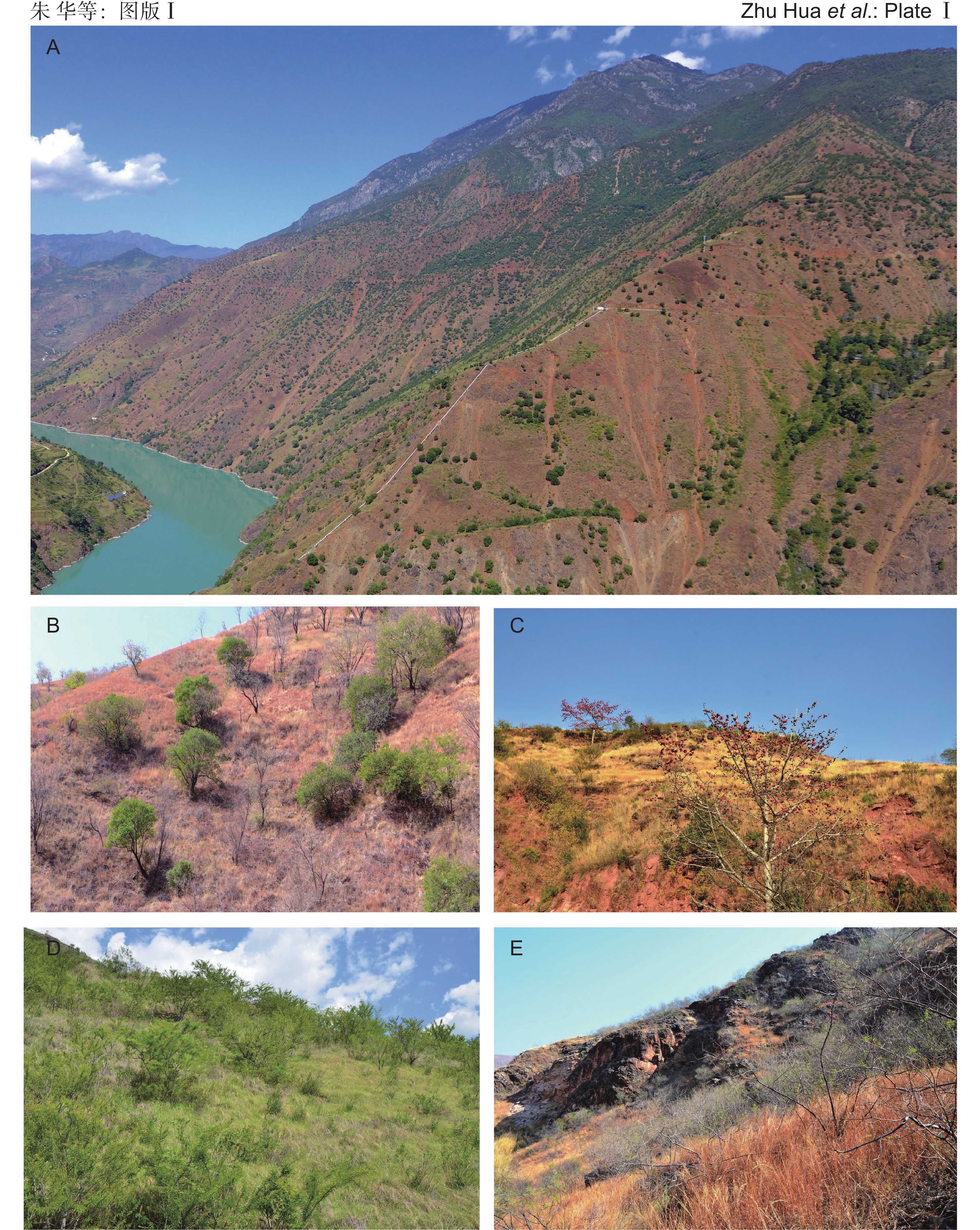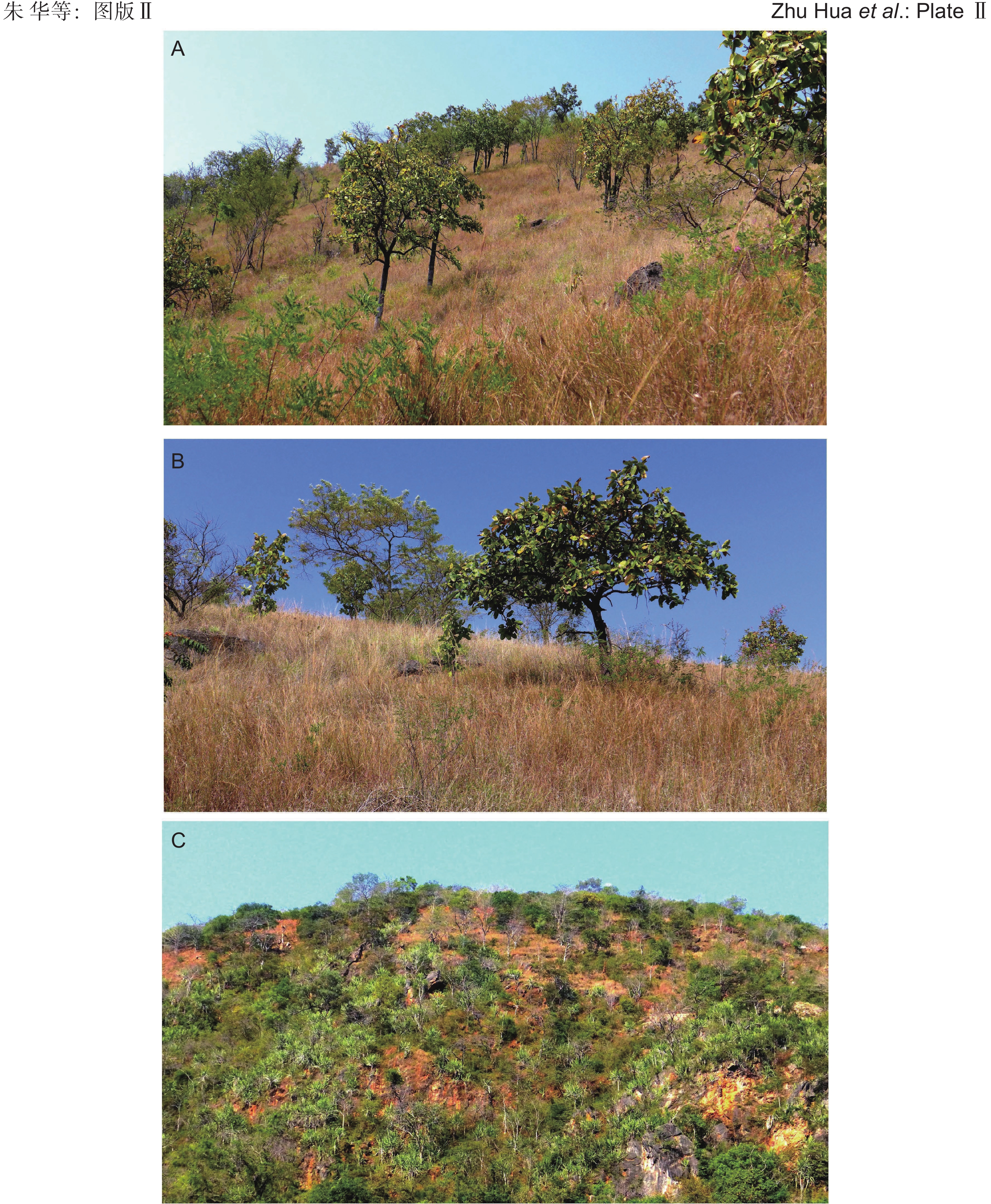Review on savanna vegetation in the dry hot river valleys of southwestern China
-
摘要:
中国西南的深切河谷因“焚风”效应形成干热河谷,具有干热性气候和河谷型萨王纳植被。萨王纳植被的植物群落以禾草占绝对优势,形成背景,其间散生灌木和乔木,在外观上类似“稀树草原”。在生活型构成上,它们以高位芽植物为主(占总种数的48.0%),但地面芽植物(占23.3%)占比较高;在叶级谱上,小叶植物占总种数的42.5%,微叶植物占20.6%;在乔木树种中,复叶占乔木总种数的39.3%,表现出明显适应干旱生境的特征。西南干热河谷萨王纳植被的植物区系总体上以热带成分占优势,但不同的干热河谷萨王纳植被的植物区系在演化过程中受地质历史和自然地理的影响发生了明显的分化。在植物区系的相似性上,金沙江干热河谷与元江干热河谷属相似性为73.8%,种相似性为53.8%,在本文比较的西南干热河谷中具有最大的属、种相似性。研究发现,中国西南干热河谷萨王纳植被和植物区系在起源和演化上与自第三纪以来,伴随着喜马拉雅的隆升,在云南发生的主要地质事件密切相关。在其植物区系中,一些种类显示与印度和非洲的萨王纳植被有关联,这在一定程度上支持印度板块从非洲分离,筏运了部分非洲植物到亚洲的理论。 金沙江与元江干热河谷具有最高的属、种相似性,支持了金沙江曾流到元江,后来因河流袭夺改道的假说。怒江干热河谷植物区系中热带成分占绝对优势,这可能与印度板块向北推挤亚洲板块,缅甸北部随之发生了北移密切相关。这些地区发生的地质历史事件可以较好地解释西南干热河谷的植物区系组成、特征和分布格局。
Abstract:The deep valleys in southwestern China experience a dry, hot climate and support savanna-like vegetation, largely shaped by the “foehn” effect. This vegetation is primarily dominated by grasses, interspersed with scattered shrubs and trees, resembling the physiognomy of savannas in other parts of the world. The savanna-like ecosystem hosts a rich diversity of species adapted to the dry, hot valley habitat, including many local endemic plants. In terms of life forms, phanerophytes dominate, accounting for 48.0% of the total species, while hemicryptophytes account for 23.3%. Regarding leaf characteristics, microphyllous and nanophyllous plants represent 42.5% and 20.6% of the total, respectively; among tree species, 39.3% have compound leaves, reflecting adaptations to arid habitats. The flora in the hot, dry valleys of southwest China are generally dominated by tropical elements, but are influenced by regional geological history and geography. Floristic similarity between the Jinshajiang and Yuanjiang river valleys is high, with 73.8% and 53.8% at the genus and species levels, respectively, representing the greatest similarity among the hot, dry valleys. The origin and evolution of this flora are closely related to major geological events in Yunnan since the Tertiary, including uplift of the Himalayas. Some species exhibit floristic affinities with the savannas of India and Africa, supporting the hypothesis that the Indian plate separated from Africa, collided with Asia, and transported African plants to the continent. The high generic similarity between the Jinshajiang and Yuanjiang river valleys supports the river capture hypothesis. In contrast, the savanna-like vegetation in the Nujiang River valley is dominated by tropical floristic elements, which is likely related to the northward push of the Indian plate into the Asian plate and the subsequent northward shift of northern Myanmar. These geological events help explain the floristic composition, characteristics, and distribution patterns of the savanna-like vegetation in the dry, hot valleys of southwestern China.
-
-
图版Ⅰ 金沙江干热河谷萨王纳植被。
A:萨王纳植被远景;B:萨王纳植被近景; C:含木棉的萨王纳植被;D:余干子-扭黄茅群落;E:疏序黄荆-扭黄茅群落。
图版Ⅰ. Savanna-like vegetation in dry, hot valleys of Jinshajiang.
A: Distant view of savanna; B: Close view of savanna; C: Savanna characterized by Bombax ceiba L.; D: Phyllanthus emblica L.-Heteropogon contortus (L.) P. Beauv. ex Roem. & Schult. community; E: Vitex negundo f. laxipaniculata C. P'ei-Heteropogon contortus (L.) P. Beauv. ex Roem. & Schult. community.
图版Ⅱ 元江干热河谷萨王纳植被。
A:萨王纳植被外貌;B:豆腐果-扭黄茅群落;C:霸王鞭刺灌丛。
图版Ⅱ. Savanna-like vegetation in dry, hot valleys of Yuanjiang.
A: Physiognomy of savanna; B: Buchanania latifolia Roxb.-Heteropogon contortus (L.) P. Beauv. ex Roem. & Schult. community; C: Succulent and thorny shrub dominated by Euphorbia royleana Boiss.
表 1 元江、怒江、金沙江干热河谷萨王纳植被的植物区系属的地理成分比较
Table 1 Comparison of geographical elements of seed plant genera among savanna vegetation flora in the dry, hot valleys of Yuanjiang, Nujiang, and Jinshajiang
比较的干热河谷植物区系
Compared regional floras元江干热河谷植物区系(475属)
Flora of Yuanjiang
(475 genera)怒江干热河谷植物区系(443属)
Flora of Nujiang
(443 genera)金沙江干热河谷植物区系(823属)
Flora of Jinshajiang
(823 genera)地理成分
Geographical elements
at genus level% % % 1世界广布Cosmopolitan 7.79 7.22 7.78 2泛热带Pantropic 33.05 27.09 20.66 3热带亚洲至热带美洲间断Tropical Asia and Tropical America disjunct 2.74 2.71 1.58 4旧世界热带Old World Tropic 10.95 9.93 7.17 5热带亚洲至热带大洋洲Tropical Asia to Tropical Australia 6.53 7.90 3.77 6热带亚洲至热带非洲Tropical Asia to Tropical Africa 7.58 9.48 5.71 7热带亚洲Tropical Asia 16.42 17.38 8.38 热带成分合计Tropical elements (types 2-7) in total* 77.26 74.49 47.27 8北温带North Temperate 6.53 9.03 18.23 9东亚及北美间断East Asia and North America disjunct 1.89 2.71 4.62 10旧世界温带Old World Temperate 2.32 2.71 7.17 11温带亚洲Temperate Asia 0.63 0.90 1.70 12地中海、西亚至中亚Mediterranean, W. Asia to C. Asia 0.42 0.45 1.34 13中亚Center Asia 0.00 0.00 0.24 14东亚East Asia 2.32 2.48 8.14 15中国特有Endemic to China 0.84 0.00 3.52 温带成分合计Temperate elements (types 8-15) in total* 14.95 18.28 44.96 总计Total 100.00 100.00 100.00 注:*为世界广布成分以外的热带成分合计和温带成分合计。 Note: * is the total of tropical and temperate elements outside the world element. 表 2 元江、怒江、金沙江干热河谷萨王纳植被的植物区系科、属、种的相似性比较
Table 2 Comparison of floristic similarities at the family, genus, and species levels among savanna vegetation flora in the dry, hot valleys of Yuanjiang, Nujiang, and Jinshajiang
比较的干热河谷植物区系
Compared regional flora元江干热河谷
(117科、475属、798种)
Yuanjiang (117 families,
475 genera, 798 species)怒江干热河谷
(110科、443属、788种)
Nujiang (110 families,
443 genera, 788 species)金沙江干热河谷
(143科、823属、2 500种)
Jinshajiang (143 families,
823 genera, 2 500 species)科相似性Similarity coefficients at family level / % 元江干热河谷Yuanjiang 100 怒江干热河谷Nujiang 87.27 100 金沙江干热河谷Jinshajiang 88.89 90.00 100 属相似性Similarity coefficients at genus level / % 元江干热河谷Yuanjiang 100 怒江干热河谷Nujiang 62.16 100 金沙江干热河谷Jinshajiang 73.84 67.80 100 种相似性Similarity coefficients at species level / % 元江干热河谷Yuanjiang 100 怒江干热河谷Nujiang 35.03 100 金沙江干热河谷Jinshajiang 53.76 42.13 100 -
[1] Zhu H,Tan YH,Yan LC,Liu FY. Flora of the savanna-like vegetation in hot dry valleys,southwestern China with implications to their origin and evolution[J]. Bot Rev,2020,86(1-2):281−297.
[2] 金振洲. 云南热带、亚热带山地灌草丛植被特点及利用途径[J]. 植物生态学与地植物学丛刊,1986,10(2):81−89. Jin ZZ. The characteristics and utilization of shrub-grasslands in tropical and subtropical mountains of Yunnan[J]. Acta Phytoecologica et Geobotanica Sinica,1986,10(2):81−89.
[3] 吴征镒. 云南植被[M]. 北京:科学出版社,1987:1024. [4] 金振洲,欧晓昆. 干热河谷植被:元江、怒江、金沙江、澜沧江[M]. 昆明:云南大学出版社,2000:302. [5] Jain AK. When did India-Asia collide and make the Himalaya?[J]. Curr Sci,2014,106(2):254−266.
[6] Tapponnier P,Lacassin R,Leloup PH,Schärer U,Zhong DL,et al. The Ailao Shan-Red River metamorphic belt:tertiary left-lateral shear between Indochina and South China[J]. Nature,1990,343(6257):431−437. doi: 10.1038/343431a0
[7] Schärer U,Tapponnier P,Lacassin R,Leloup PH,Zhong D,et al. Intraplate tectonics in Asia:a precise age for large-scale Miocene movement along the Ailao Shan-Red River shear zone,China[J]. Earth Planet Sci Lett,1990,97(1-2):65−77. doi: 10.1016/0012-821X(90)90099-J
[8] Leloup PH,Lacassin R,Tapponnier P,Schärer U,Zhong DL,et al. The Ailao Shan-Red River shear zone (Yunnan,China),Tertiary transform boundary of Indochina[J]. Tectonophysics,1995,251(1-4):3−10. doi: 10.1016/0040-1951(95)00070-4
[9] Sato K,Liu YY,Wang YB,Yokoyama M,Yoshioka S,et al. Paleomagnetic study of Cretaceous rocks from Pu'er,western Yunnan,China,Evidence of internal deformation of the Indochina block[J]. Earth Planet Sci Lett,2007,258(1-2):1−15. doi: 10.1016/j.jpgl.2007.02.043
[10] Sato K,Liu YY,Zhu ZC,Yang ZY,Otofuji YI. Tertiary paleomagnetic data from northwestern Yunnan,China:further evidence for large clockwise rotation of the Indochina block and its tectonic implications[J]. Earth Planet Sci Lett,2001,185(1-2):185−198. doi: 10.1016/S0012-821X(00)00377-0
[11] Chen HH,Dobson J,Heller F,Jie H. Paleomagnetic evidence for clockwise rotation of the Simao region since the Cretaceous:a consequence of India-Asia collision[J]. Earth Planet Sci Lett,1995,134(1-2):203−217. doi: 10.1016/0012-821X(95)00118-V
[12] Clark MK,Schoenbohm LM,Royden LH,Whipple KX,Burchfiel BC,et al. Surface uplift,tectonics,and erosion of eastern Tibet from large-scale drainage patterns[J]. Tectonics,2004,23(1):TC1006, doi: 10.1029/2002TC001402.
[13] Zhou Z,Gu BJ,Sun H,Zhu H,Tan YH. Molecular phylogenetic analyses of Euphorbiaceae tribe Epiprineae,with the description of a new genus,Tsaiodendron gen. nov.,from south-western China[J]. Bot J Linn Soc,2017,184(2):167−184.
[14] Zhang CF,Huang CH,Liu M,Hu Y,Panero JL,et al. Phylotranscriptomic insights into Asteraceae diversity,polyploidy,and morphological innovation[J]. J Integr Plant Biol,2021,63(7):1273−1293. doi: 10.1111/jipb.13078
[15] Cao SY,Liu JL,Leiss B,Neubauer F,Genser J,et al. Oligo-Miocene shearing along the Ailao Shan–Red River shear zone:constraints from structural analysis and zircon U/Pb geochronology of magmatic rocks in the Diancang Shan massif,SE Tibet,China[J]. Gondwana Res,2011,19(4):975−993. doi: 10.1016/j.gr.2010.10.006
[16] 朱华. 地质事件和季风气候影响了云南植物区系和植被的演化[J]. 生物多样性,2023,31(12):23262. doi: 10.17520/biods.2023262 Zhu H. Flora and vegetation of Yunnan are shaped by geological events and monsoon climate[J]. Biodiversity Science,2023,31(12):23262. doi: 10.17520/biods.2023262
[17] Scholes RJ,Archer SR. Tree-grass interactions in savannas[J]. Annu Rev Ecol Syst,1997,28:517−544. doi: 10.1146/annurev.ecolsys.28.1.517
[18] 龚子同,陈志诚,骆国保,张甘霖,赵文君. 中国土壤系统分类参比[J]. 土壤,1999,31(2):57−63. [19] 金振洲. 滇川干热河谷种子植物区系成分研究[J]. 广西植物,1999,19(1):1−14. Jin ZZ. The floristic study on seed plants in the dry-hot valleys in Yunnan and Sichuan[J]. Guihaia,1999,19(1):1−14.
[20] 金振洲. 云南元江干热河谷半萨王纳植被的植物群落学研究[J]. 广西植物,1999,19(4):289−302. Jin ZZ. A phytosociological study on the semi-savanna vegetation in the dry-hot valleys of Yuanjiang River,Yunnan[J]. Guihaia,1999,19(4):289−302.
[21] 金振洲. 滇川干热河谷与干暖河谷植物区系特征[M]. 昆明:云南科技出版社,2002:226. [22] 欧晓昆. 元谋干热河谷植物区系研究[J]. 云南植物研究,1988,10(1):11−18. Ou XK. The study of flora in Yuanmou dry-hot river valley[J]. Acta Botanica Yunnanica,1988,10(1):11−18.
[23] 曹敏,金振洲. 云南巧家金沙江干热河谷的植被分类[J]. 云南植物研究,1989,11(3):324−336. Cao M,Jin ZZ. Classification of vegetation in Qiaojia dry-hot river valley of Jinsha river,Yunnan[J]. Acta Botanica Yunnanica,1989,11(3):324−336.
[24] 曹永恒. 云南潞江坝怒江干热河谷植物区系研究[J]. 云南植物研究,1993,15(4):339−345. Cao YH. A research on the flora of Nujiang dry-hot valley in Lujiangba of Yunnan[J]. Acta Botanica Yunnanica,1993,15(4):339−345.
[25] 曹永恒,金振洲. 云南潞江坝怒江干热河谷植被研究[J]. 广西植物,1993,13(2):132−138. Cao YH,Jin ZZ. A research on the vegetation of Nujiang dry-hot river valley in Lujiangba of Yunnan[J]. Guihaia,1993,13(2):132−138.
[26] 沈泽昊. 中国西南干旱河谷的植物多样性:区系和群落结构的空间分异与成因[J]. 生物多样性,2016,24(4):363−366. doi: 10.17520/biods.2016049 Shen ZH. Plant diversity in the dry valleys of Southwest China:spatial deviation and determinants for flora and plant communities[J]. Biodiversity Science,2016,24(4):363−366. doi: 10.17520/biods.2016049
[27] 沈泽昊,张志明,胡金明,韩杰,杨济达,等. 西南干旱河谷植物多样性资源的保护与利用[J]. 生物多样性,2016,24(4):475−488. doi: 10.17520/biods.2016022 Shen ZH,Zhang ZM,Hu JM,Han J,Yang JD,et al. Protection and utilization of plant biodiversity resources in dry valleys of Southwest China[J]. Biodiversity Science,2016,24(4):475−488. doi: 10.17520/biods.2016022
[28] 刘晔,朱鑫鑫,沈泽昊,孙航. 中国西南干旱河谷植被的区系地理成分与空间分异[J]. 生物多样性,2016,24(4):367−377. doi: 10.17520/biods.2015240 Liu Y,Zhu XX,Shen ZH,Sun H. Flora compositions and spatial differentiations of vegetation in dry valleys of Southwest China[J]. Biodiversity Science,2016,24(4):367−377. doi: 10.17520/biods.2015240
[29] 杨济达,张志明,沈泽昊,欧晓昆,耿宇鹏,等. 云南干热河谷植被与环境研究进展[J]. 生物多样性,2016,24(4):462−474. doi: 10.17520/biods.2015251 Yang JD,Zhang ZM,Shen ZH,Ou XK,Geng YP,et al. Review of research on the vegetation and environment of dry-hot valleys in Yunnan[J]. Biodiversity Science,2016,24(4):462−474. doi: 10.17520/biods.2015251
[30] 李云琴,杜凡,汪健. 金沙江上游干旱河谷维管植物区系特征[J]. 西部林业科学,2019,48(1):93−99,138. Li YQ,Du F,Wang J. Floristic characteristics of vascular plants in dry valleys of the upstream of Jinsha River[J]. Journal of West China Forestry Science,2019,48(1):93−99,138.
[31] 李云琴,杜凡,汪健,李瑞年,刘洋. 金沙江上游干旱河谷植被[J]. 生物多样性,2016,24(4):489−494. doi: 10.17520/biods.2015238 Li YQ,Du F,Wang J,Li RN,Liu Y. Desert vegetation in dry valleys of the upstream of Jinsha River[J]. Biodiversity Science,2016,24(4):489−494. doi: 10.17520/biods.2015238
[32] Loidi J,Herrera M,Olano JM,Silván F. Maquis vegetation in the eastern Cantabrian coastal fringe[J]. J Veg Sci,1994,5(4):533−540. doi: 10.2307/3235980
[33] 朱华,杜凡. 设立云南金沙江干热河谷萨王纳植被自然保护地的建议[J]. 生物多样性,2022,30(3):21519, doi: 10.17520/biods.2021519. Zhu H,Du F. Suggestion to establish a nature reserve for protecting native savanna vegetation in hot dry valley of Jinshajiang,Yunnan[J]. Biodiversity Science,2022,30(3):21519, doi: 10.17520/biods.2021519.
[34] Zhu H,Ashton P,Gu BJ,Zhou SS,Tan YH. Tropical deciduous forest in Yunnan,southwestern China:implications for geological and climatic histories from a little-known forest formation[J]. Plant Diversity,2021,43(6):444−451. doi: 10.1016/j.pld.2021.01.001
[35] 朱华. 元江干热河谷肉质多刺灌丛的研究[J]. 云南植物研究,1990,12(3):301−310. Zhu H. A study on the thorny succulent shrubs in dry-hot valley of Yuanjiang County[J]. Acta Botanica Yunnanica,1990,12(3):301−310.
[36] 朱华. 云南的硬叶常绿阔叶林——古地中海残余植被[J]. 广西植物,2023,43(2):234−241. Zhu H. Sclerophyllous evergreen broad-leaved forest in Yunnan:a remnant vegetation related to Tethys[J]. Guihaia,2023,43(2):234−241.
[37] 刘方炎,朱华,施济普,陈晓鸣. 元江干热河谷植物群落特征及土壤肥力研究[J]. 应用与环境生物学报,2007,13(6):782−787. Liu FY,Zhu H,Shi JP,Chen XM. Characteristics of plant communities and their soil fertilities in dry-hot valley of Yuanjiang County,Yunnan,China[J]. Chinese Journal of Applied & Environmental Biology,2007,13(6):782−787.
[38] 顾伯键. 云南绿汁江下游与元江干热河谷普漂段季雨林与萨王纳植被的群落学研究[D]. 北京:中国科学院研究生院,2015:1−10. [39] 金振洲,杨永平,陶国达. 华西南干热河谷种子植物区系的特征、性质和起源[J]. 云南植物研究,1995,17(2):129−143. Jin ZZ,Yang YP,Tao GD. The floristic characteristics,nature and origin of seed plants in the dry-hot river valley of SW China[J]. Acta Botanica Yunnanica,1995,17(2):129−143.
[40] Hall R. The plate tectonics of Cenozoic SE Asia and the distribution of land and sea[M]//Hall R,Holloway JD,eds. Biogeography and Geological Evolution of SE Asia. Leiden:Backhuys Publishers,1998:99−131.
[41] Mitchell AHG. Cretaceous-Cenozoic tectonic events in the western Myanmar (Burma)-Assam region[J]. J Geol Soc,London,1993,150(6):1089−1102. doi: 10.1144/gsjgs.150.6.1089
[42] Morley RJ. Assembly and division of the South and South-East Asian flora in relation to tectonics and climate change[J]. J Trop Ecol,2018,34(4):209−234. doi: 10.1017/S0266467418000202
[43] Bansal M,Morley RJ,Nagaraju SK,Dutta S,Mishra AK,et al. Southeast Asian Dipterocarp origin and diversification driven by Africa-India floristic interchange[J]. Science,2022,375(6579):455−460. doi: 10.1126/science.abk2177
[44] Ma H,Wang DS,Li TQ,Li ZH. Phylogeographic study of Musella lasiocarpa (Musaceae):providing insight into the historical river capture events[J]. Pak J Bot,2019,51(1):191−199, doi: 10.30848/PJB2019-1(17).
[45] Zhang TC,Sun H. Phylogeographic structure of Terminalia franchetii (Combretaceae) in southwest China and its implications for drainage geological history[J]. J Plant Res,2011,124(1):63−73. doi: 10.1007/s10265-010-0360-3
[46] Zhang TC,Comes HP,Sun H. Chloroplast phylogeography of Terminalia franchetii (Combretaceae) from the eastern Sino-Himalayan region and its correlation with historical river capture events[J]. Mol Phylogenet Evol,2011,60(1):1−12. doi: 10.1016/j.ympev.2011.04.009
[47] Wang HC,He ZR,Wang YH,Sun H. Bupleurum dracaenoides (Subgenus Bupleurum,Apiaceae):a new shrubby species from Southwestern China[J]. Syst Bot,2013,38(4):1188−1195. doi: 10.1600/036364413X674751
[48] Blasco F,Bellan MF,Aizpuru M. A vegetation map of tropical continental Asia at scale 1:5 million[J]. J Veg Sci,1996,7(5):623−634. doi: 10.2307/3236374
[49] Sankaran M,Hanan NP,Scholes RJ,Ratnam J,Augustine DJ,et al. Determinants of woody cover in African savannas[J]. Nature,2005,438(7069):846−849, doi: 10.1038/nature04070.
[50] 任海,Daane J,彭少麟. 非洲稀树草原生态系统概况[J]. 热带亚热带植物学报,2002,10(4):381−390. Ren H,Daane J,Peng SL. Ecosystem of savanna in Africa[J]. Journal of Tropical and Subtropical Botany,2002,10(4):381−390.
[51] Mivoria JK. Resilience of soils and vegetation in veld[J]. Afr J Range Forest Sci,1997,14:26−31. doi: 10.1080/10220119.1997.9647915




 下载:
下载:

